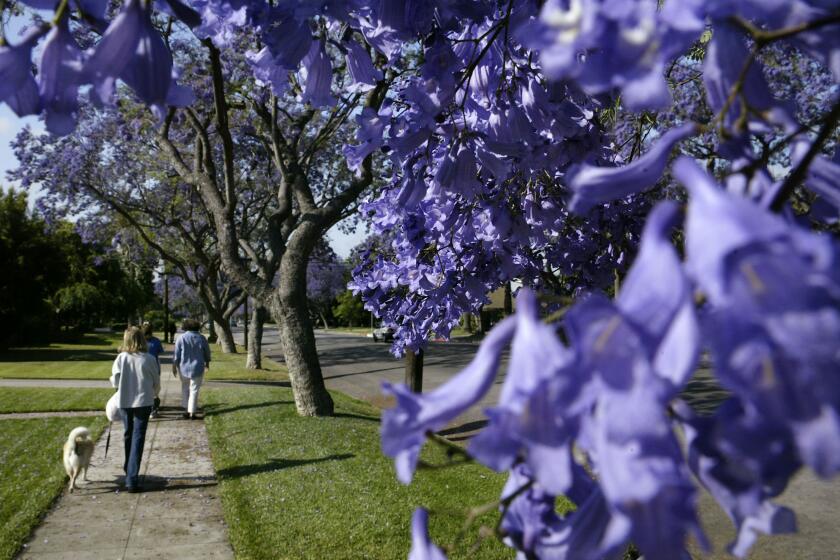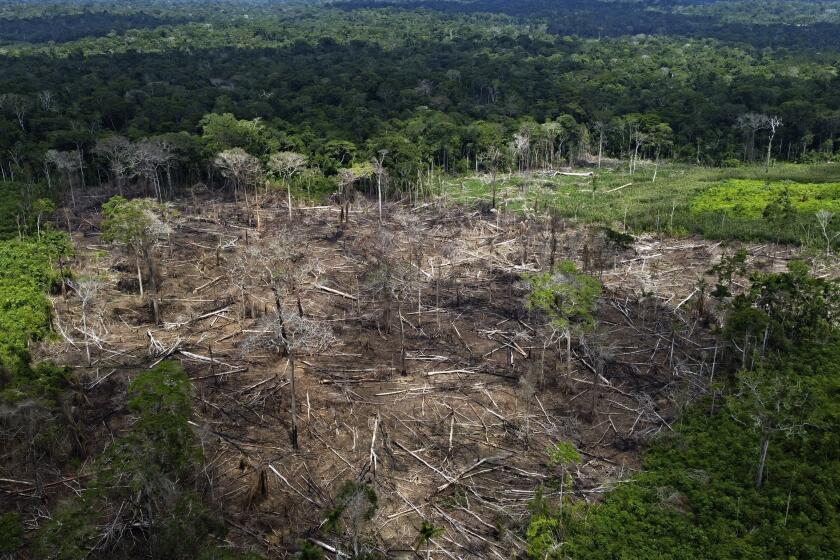Is planting trees on Arbor Day one way we can all fight climate change? Not so much

- Share via
Arbor Day has its roots in the 1870s, when the horticulturist J. Sterling Morton spearheaded a movement to green Nebraska’s largely treeless plains. Since then, citizens, businesses and governments have marked April 26 by planting trees in schoolyards, parks and neighborhoods.
In recent years, tree-planting has been touted as no less than a means of empowering people to combat climate change. Gratifying and photographable, planting a tree seems to be a small but tangible act that almost anyone can undertake to reduce their carbon footprint and feel good about it.
The science, however, suggests a more strategic use of our time and resources. Newly planted trees take many years to become effective carbon sinks. By contrast, properly caring for the forests we already have — and letting them grow older — can make a huge difference immediately.
Los Angeles gardens and landscapes won’t support the environment and threatened wildlife unless they use native plants. Low water use isn’t enough.
Instead of simply mass-planting saplings on Arbor Day or any other occasion, governments, businesses and people should look for ways to restore and conserve forests. The hard truth is that a singular focus on planting can cause us to literally and figuratively miss the forest — and its much greater import to the climate — for the trees.
Recent studies show widespread planting of trees isn’t the panacea it once promised to be. Thomas Crowther, the former chief scientific advisor for the U.N.’s Trillion Trees Campaign, came forward last year to un-sing the praises of the cause he once popularized, telling the COP28 climate conference that tree-planting isn’t as helpful as was once claimed. In a study published by Nature last year, more than 200 scientists joined Crowther in concluding that restoring and sustainably managing existing forests is the most efficient means to capture enough carbon to meet the Paris climate accord’s goals by 2030.
Investing in new trees is risky and slow to make a dent in climate change. They take decades of intensive management before they significantly reduce the level of carbon in the atmosphere. And climate stresses such as extreme weather, invasive pests and diseases, along with a lack of long-term investment, can cause new trees to fail.
In 2022, the world lost more than 11 soccer fields of tropical forest per minute.
Maintaining and reviving older, more natural forests is far more effective. And the science shows that in the United States in particular, allowing our largely young forests to mature is a critically important piece of the solution to the climate crisis.
Older, more natural forests clean the air we breathe, provide homes for wildlife, strengthen watersheds that provide clean water to more than 180 million Americans and give us amazing outdoor spaces to enjoy. And as trees age and grow, their carbon stores increase exponentially.
The Nature study found that worldwide forest restoration could remove a staggering 226 gigatons of carbon dioxide from the atmosphere, the equivalent of approximately 20 years of global emissions from burning fossil fuels. But privately owned forests, which account for 60% of the U.S. total, are not adequately protected. Every year, the United States loses 2.2 million acres of forest, an area the size of Delaware, to development.
Calling for the restoration of whole forests is one thing, but realizing that goal is another. One way to prioritize responsible forest management is through conservation easements for managed forests, which pay landowners to permanently protect their forests while allowing sustainable timber production.
In California alone, easements and responsible management of forests have the potential to reduce carbon dioxide emissions by about 150 million to 300 million metric tons in a decade. That exceeds the estimated reductions in emissions the state would expect from electrification of the entire transportation sector.
Forests managed with a focus on climate resilience also decrease the likelihood of severe wildfires, which have caused more than $21 billion in damage in California over a recent five-year span. Management practices that promote more natural conditions not only make forests less vulnerable to fires but also improve watersheds and increase protection from climate challenges such as droughts.
Managing and conserving natural and working forests — much more than starting from scratch by planting trees that will take tens and hundreds of years to become forests — is key to our future. It deserves at least as much attention as the transition to clean energy and transportation.
I’m certainly looking forward to seeing volunteers out planting trees this Arbor Day, which beautifies cities, shades us from scorching temperatures and enhances air quality. But I’m more eager to see people, businesses and governments collaborate to make our forests the climate-change-fighting powerhouses they can and must be.
Laurie Wayburn is a co-founder and the president of Pacific Forest Trust.
More to Read
A cure for the common opinion
Get thought-provoking perspectives with our weekly newsletter.
You may occasionally receive promotional content from the Los Angeles Times.











